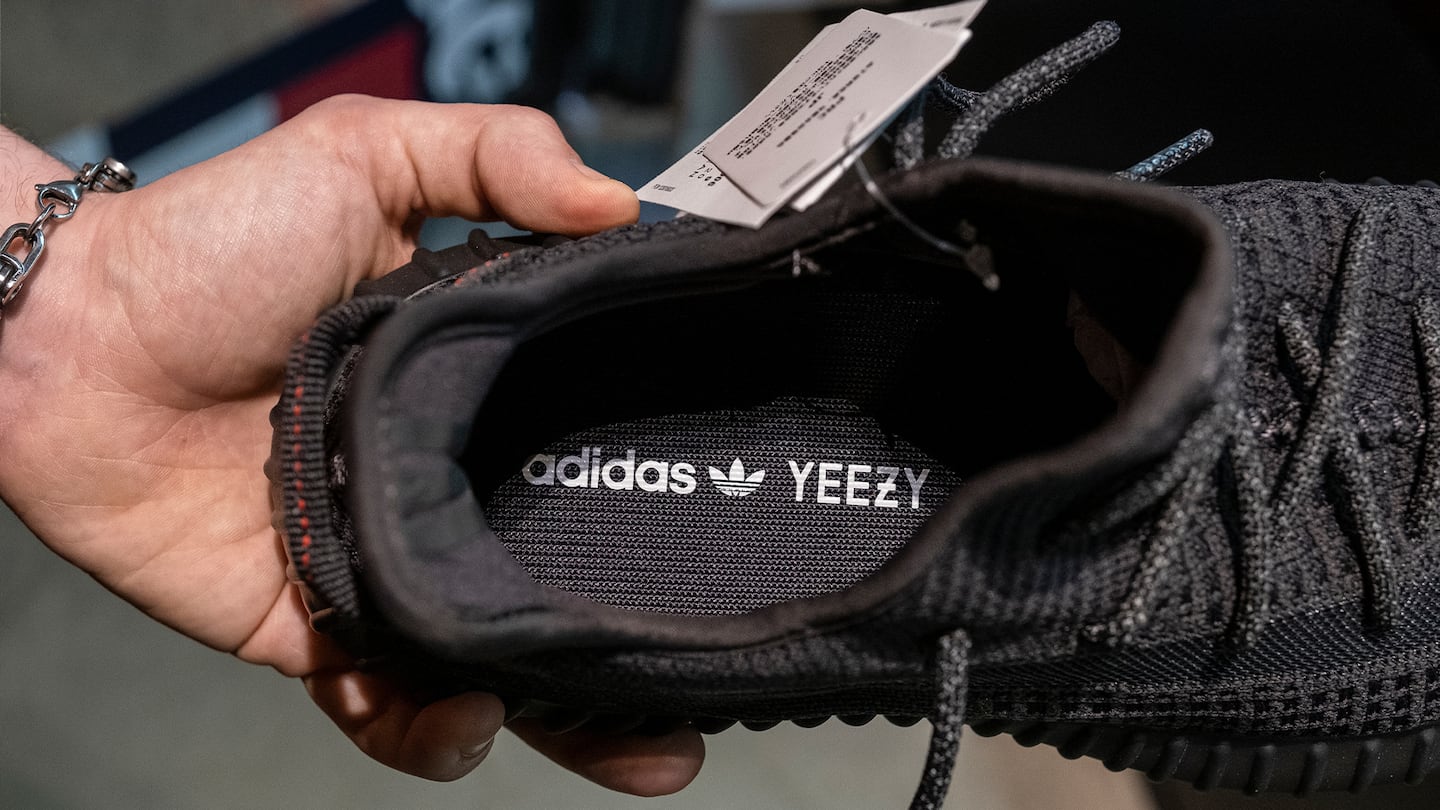
The Business of Fashion
Agenda-setting intelligence, analysis and advice for the global fashion community.

Agenda-setting intelligence, analysis and advice for the global fashion community.

Adidas is inching closer to solving its Yeezy dilemma.
The German sports giant indicated on Wednesday that it is exploring options to offload rather than destroy its Yeezy merchandise following the fallout of the costly breakup with its once-star collaborator Ye, the artist and designer formerly known as Kanye West.
New CEO Bjørn Gulden, who took the helm in January, said that while he has yet to make a final decision on what to do with the unsold inventory, it’s likely that the company will sell the overstock to off-price channels or other distributors, and donate the proceeds to social justice organisations.
“People who’ve been hurt by [the Yeezy controversy] will benefit from donations or proceeds” from any future sale of the sneakers, Gulden said in an earnings call Wednesday morning.
ADVERTISEMENT
Yeezy accounted for about seven percent of Adidas’ sales, and the abrupt end of the collaboration could cost the company over €500 million ($540 million) in losses this year.
Gulden, discussing the topic publicly for the first time, described the company’s next steps as “the most difficult decision of my career.” But he was clearer on Adidas’ post-Yeezy future: there will be no single replacement for the lost business and never again will the brand rely on an individual collaboration.
“It’s something we need to replace with many, many different pieces,” he said. “There is no other Yeezy business out there in the market.”
More likely, Adidas will tap a high-profile creative director, as Louis Vuitton and Puma have done in recent weeks, said Adam Cochrane, retail and luxury analyst at Deutsche Bank Research.
Moving on from last year’s troubles won’t be so easy. In its earnings report Wednesday, Adidas largely confirmed its profit warning in February: It projects a €700 million ($738 million) operating loss for 2023 — its first negative income in 31 years — as it deals with the hangover from the most chaotic period in its history. Unsold Yeezy products would account for the majority of that loss, or €500 million, if Adidas were to write off that stock entirely, while the rest is allocated for costs incurred by its turnaround efforts to be profitable again by 2024.
Along with the disintegration of the billion-dollar Yeezy deal, the company is suffering from bloated inventories, plummeting sales in China and the termination of its Russia business following the invasion of Ukraine.
Revenue grew by six percent year-on-year in 2022 to €22.5 billion ($23.7 billion), while gross margin fell by 3.4 percentage points. Weak sales in China, once the brand’s most profitable market, contributed significantly to the shortfall, and revenue in the region was down 31 percent year-on-year. The brand also slashed its dividend, announcing a payout of €0.70 per share, down from €3.30 in 2021.
“Yeezy, China — our single biggest market — and Russia were three major profit pools that we lost last year,” chief financial officer Harm Ohlmeyer said.
ADVERTISEMENT
Gulden, just seven weeks into his tenure as the brand’s chief executive, struck a more optimistic tone when he outlined the first steps of his turnaround plan for the struggling sportswear giant. He said that demand in China is finally picking up following the country’s reopening in January, and added that he expects the brand to be clear of its excess inventory issues by the second half of the year.
Adidas shares rose 2 percent Wednesday to close at $147.50, the highest price since the company issued its profit warning last month.
With its $1.3 billion-worth of Yeezy products at hand, Adidas has two options: to sell or destroy the goods currently collecting dust in the company’s warehouses. Both approaches have drawbacks.
“Selling the product normally … causes a lot of reputational risk,” Gulden said. “The other side is we burn it or do whatever it takes to destroy it and it disappears, then you have another issue” — that of sustainability.
At one point, Gulden answers an analyst’s question regarding the overstock with a question himself: “If you can’t sell and you can’t destroy, what’s your option?” he said to the analyst, who replied, “Well, that’s why I’m confused. I’m not running the brand.”
At this stage, it appears unlikely the brand will simply destroy the remaining inventory, experts say. Gulden himself expressed concerns that doing so would raise various practical and moral issues.
“We could sell [the sneakers] with a small margin and give the margin away for different donations,” he said. “We can sell them with more margin and give more donations. I think the goal that we have is to do what the probability is that it damages us the least and we do something good.”
Gulden added that since January, he has received over 500 offers to buy the rights to the existing Yeezy stock, but that he believed these options “would not necessarily be the right thing to do.”
ADVERTISEMENT
Cochrane said that the best solution is to sell.
“Selling remaining stock can make the best out of the situation by recovering some of the lost profit and costs,” he said. “I think to sell it themselves and to split the proceeds with the charity will be the most likely outcome.”
Gulden also stated that to sell the sneakers without the Yeezy branding — originally discussed as an option for the brand in the wake of the crisis — would be “dishonest.”
In addition to grappling with the Yeezy situation, Gulden announced an executive shakeup which will see him assume the responsibilities of the departing Brian Grevy, head of global brands. Gulden will take control of brand partnerships and marketing. In this role, he intends to overhaul Adidas’ faltering lifestyle business by refining its collaborations strategy, tapping into the playbook used to turn around the brand’s local rival Puma when he took over in 2013. Gulden’s approach focussed on signing big-name, long-term collaborators such as Rihanna, as well as signing partnerships with athletes from niche sports the brand’s rivals had less of a presence in, like Formula 1, or even chess.
Adidas’ previous approach, under which the brand partnered with Balenciaga, Prada and Gucci, along with a host of celebrities including Pharrell Williams, reggaeton star Bad Bunny and actress Jenna Ortega, didn’t quite resonate with customers. Despite these high-profile tie-ups, revenue for the brand’s lifestyle segment fell five percent last year compared to 2021.
“Maybe Adidas has done too much in trying to connect itself with culture through these collabs, but we are now connected with the biggest brands in terms of fashion,” Gulden said. “Hopefully we can execute it a little better.”
Adidas’ lifestyle business is set to be boosted by the imminent rollout of the streetwear-basketball collaboration with Jerry Lorenzo’s Fear of God, which is slated to be a long-term partnership.
In China, the brand is expecting sales to finally pick up in the first half of this year, following the country’s reopening in January. Gulden has empowered the regional leadership team with greater decision-making autonomy, he said, and this will result in a more localised approach to marketing and merchandising. Already, Adidas is seeing significant demand in China for lifestyle sneakers such as the Samba and Gazelle styles, Gulden said.
In the coming quarters, China, along with North America, is expected to be the brand’s key growth engine under Gulden’s turnaround strategy, according to Cochrane.
The brand also expects to be clear of its excess inventory issue by the second half of 2023, leaning on wholesale to shift excess stock.
“Gulden has had more friendly dealings with retailers than maybe Adidas has in the past,” Cochrane said. “So I think you will get a bit of goodwill coming from these retailers who will then give Adidas products a chance.”
On Wednesday, Gulden emphasised the need for the brand to return to the basics right, such as inventory management, offering products that resonate with consumers, athlete partnerships and strengthening links with retailers. He pointed to the brand already getting to work signing athletes in niche sports to help the brand access specific consumer groups — another tactic from his Puma days — particularly in regions like China, as a way for Adidas to remain competitive in the market.
As for its big-ticket marketing moments, the brand has had a good run in recent months, Yeezy controversy notwithstanding. In December, Adidas’ highest-profile sponsored athlete Lionel Messi won the Adidas-sponsored World Cup in Qatar, while Adidas-sponsored American football player Patrick Mahomes won his second Super Bowl in February.
“2023 will be a transition year to build the base for [the future],” said Gulden. “We can then start to build a profitable business again in 2024.”
Top of incoming CEO Bjørn Gulden’s in-tray will be dealing with unsold Yeezy inventory and reversing the brand’s steep decline in China.
The sportswear giant cut its profitability forecast for the fourth time this year as it continues to confront the fallout from its split with Ye.
The German sportswear giant’s partnership with Ye generated $1.7 billion in 2021, accounting for nearly 7 percent of its annual revenue. Now that the company has cut ties with the rapper, will it keep selling Yeezy designs?

Daniel-Yaw Miller is Senior Editorial Associate at The Business of Fashion. He is based in London and covers menswear, streetwear and sport.
As the German sportswear giant taps surging demand for its Samba and Gazelle sneakers, it’s also taking steps to spread its bets ahead of peak interest.
A profitable, multi-trillion dollar fashion industry populated with brands that generate minimal economic and environmental waste is within our reach, argues Lawrence Lenihan.
RFID technology has made self-checkout far more efficient than traditional scanning kiosks at retailers like Zara and Uniqlo, but the industry at large hesitates to fully embrace the innovation over concerns of theft and customer engagement.
The company has continued to struggle with growing “at scale” and issued a warning in February that revenue may not start increasing again until the fourth quarter.